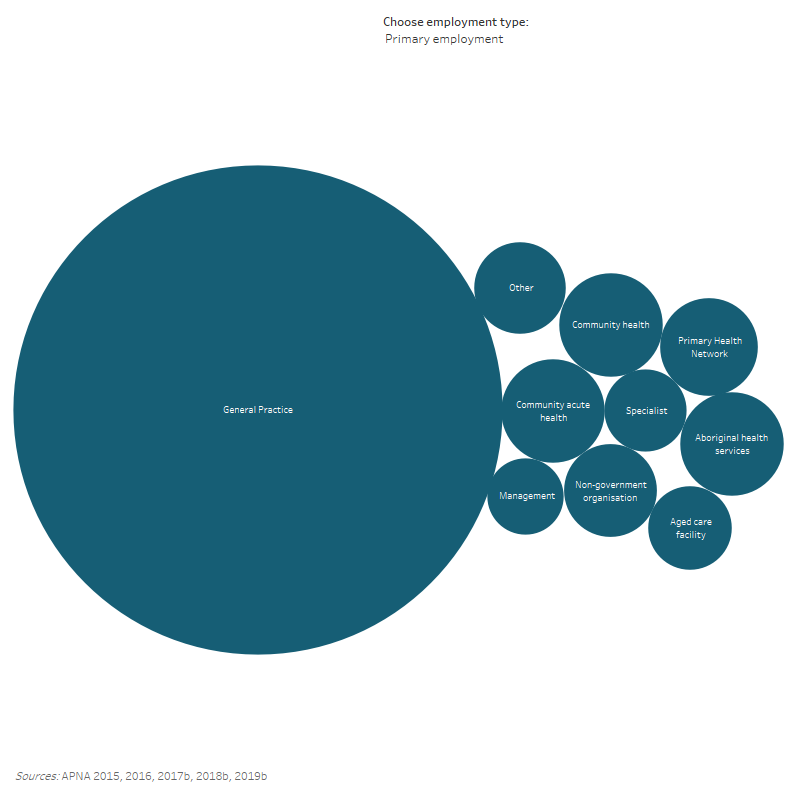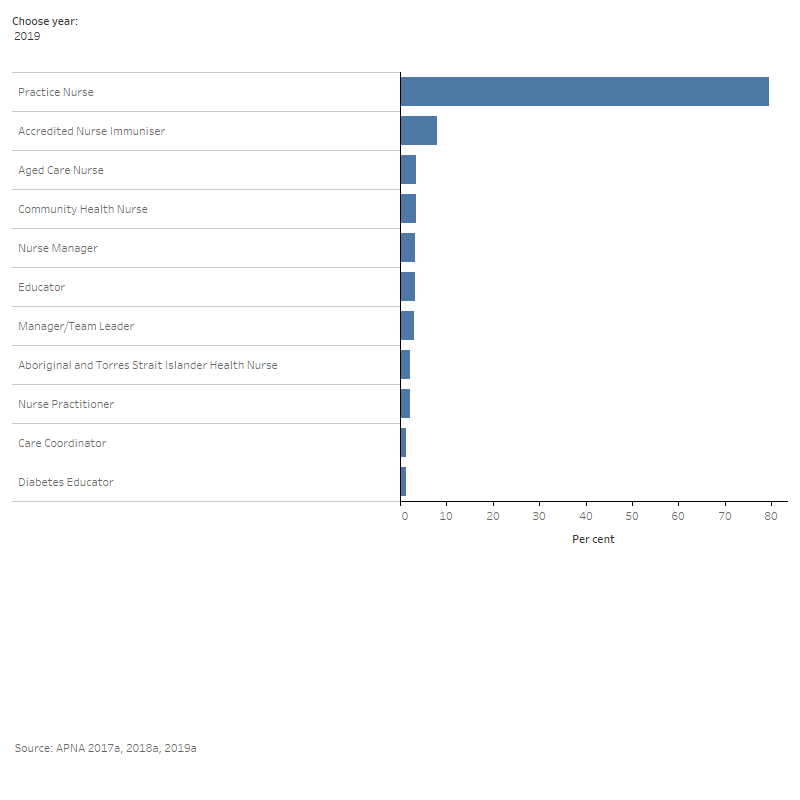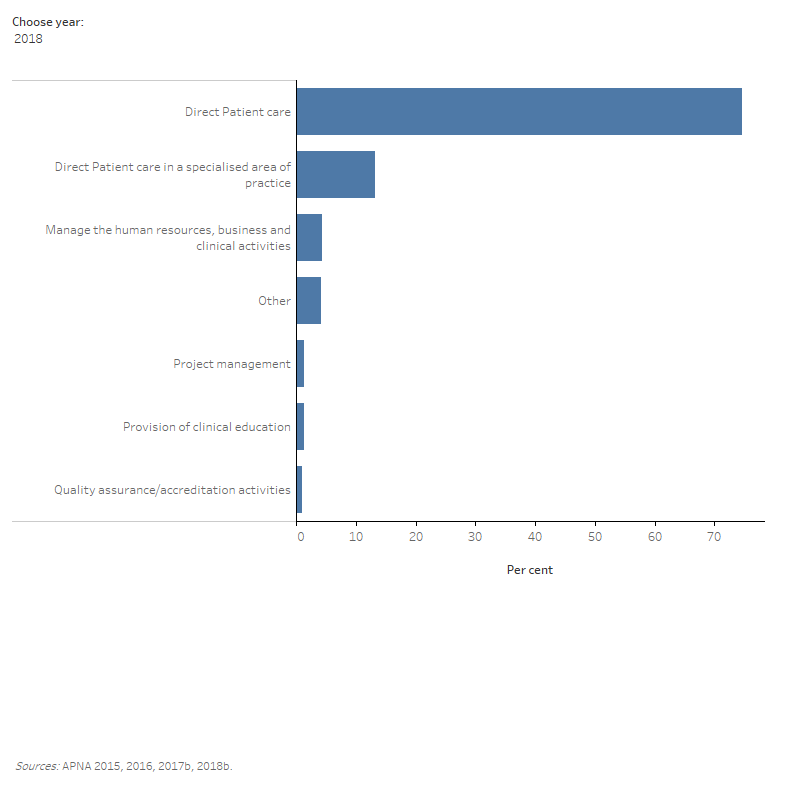Where do primary health care nurses work?
Primary health care nurses play a key role in health care and work in a variety of settings including general practice clinics and community health services.
The APNA Survey results show that:
- general practice settings were the top primary place of employment for primary health care nurses between 2015 and 2019, with 2 out of 3 (68%) of survey respondents reporting they primarily worked in a general practice setting in 2019
- following general practices, 'other’ (2%), community health (3%), community acute health (3%), Primary Health Network (3%) and Aboriginal health (3%) were the most popular place of primary employment in 2019
- acute hospital settings were the top secondary place of employment for survey respondents in 2019
- general practice settings remained in the top three place of secondary employment between 2015 and 2019 (Figure 5).
Figure 5: Primary and secondary places of employment among primary health care nurses, 2015–2019
Figure 5 Alternative text: The figure shows the top ten primary and secondary places of employment of the APNA Survey respondents between 2015 and 2019. Over this period, GP settings accounted for the highest proportion of survey respondents’ primary place of employment, 68% in 2019. In 2019, 16.8% of respondents worked in acute hospital settings as a secondary place of employment.

What roles do primary health care nurses work in?
Primary health care nurses work in a wide range of roles including practice nurses, nurse educators, aged care and Aboriginal and Torres Strait Islander health nurses. Between 2017 and 2019, practice nurses accounted for the largest proportion of primary health care nurses. In 2019, 79% of nurses worked as practice nurses, 8.1% were accredited nurse immunisers and 3.5% were aged care nurses (Figure 6).
Figure 6: Workplace roles among primary health care nurses, 2017–2019
Figure 6 Alternative text: The figure shows the top ten APNA member positions between 2017 and 2019. Over this period, the highest proportion of members worked as practice nurses. The top three positions of APNA members in both 2018 and 2019 were practice nurses, accredited nurse immunisers and aged care nurses.

Direct patient care is the most common role among primary health care nurses
Primary health care nurses play a key role in delivering continuity of care to patients and improving health outcomes (APNA, 2020b). In 2018, 3 in 4 (75%) survey respondents reported that their main role or focus in their role was direct patient care (Figure 7).
Figure 7: Main role among primary health care nurses, 2015–2018
Figure 7 Alternative text: This figure shows the proportion of survey respondents describing the main focus of their role in the primary job between 2015 and 2018. In 2018, 3 in 4 respondents (75%) stated that their main focus in their primary setting was direct patient care.

Primary health care nurses report career experience
APNA member registration data show a large proportion of primary health care nurses self-reported being ‘experienced’. Over 2 out of 5 nurses (43%) reported being ‘an experienced nurse in primary health care’. Over a quarter (28%) reported being ‘an experienced nurse new to primary health care’ (Figure 8).
Figure 8: Career stage of primary health care nurses, 2017–2019
Figure 8 Alternative text: The figure shows the stage of career of APNA members between 2017 and 2019. Over this period, the highest proportion of respondents were from the experienced nurses skilled or new to primary health care categories. In 2019, 71% of respondents were from these categories.

Job flexibility is important to primary health care nurses
Between 2015 and 2019, the top three most important factors which influenced a nurse’s decision to work in primary health care included: improved working hours, ability to balance life and work responsibilities, and ability to stop working shift work. The least important factor across all survey years was the ‘first employment opportunity’.
In 2019, almost two-thirds (61%) of survey respondents reported having the ability to balance life and work responsibilities was a ‘very important’ factor in influencing their decision to become a primary health care nurse or midwife (Figure 9).
Figure 9: Factors influencing decision to become a primary health care nurse/midwife, 2015–2019
Figure 9 Alternative text: The figure shows the proportion of respondents votes against a range of factors that influenced their decision to become a primary health care nurse/midwife between 2015 and 2019. In 2019, the ability to balance life and work responsibilities and improved working hours was voted very important by respondents, 61% and 59% respectively.

Most primary health care nurses have permanent positions
In 2019, over 7 in 10 (74%) of primary health care nurses reported working on a permanent basis in their primary place of employment, and almost 1 in 5 report working on a casual basis (18%).
Figure 10: Employment status of primary health care nurses in their primary place of employment, 2015–2019
Figure 10 Alternative text: This figure shows the proportion distribution of survey respondents employment basis in their primary job setting between 2015 and 2019. In 2019, 74% of respondents reported they were employed on a permanent basis whilst 18% reported they were employed on a casual basis.

References
Australian Primary Health Care Nurse Association (APNA) 2017a. APNA Annual Report 2018. Melbourne: APNA.
APNA 2018a. APNA Annual Report 2018. Melbourne: APNA.
APNA 2019a. APNA Annual Report 2018. Melbourne: APNA.
APNA 2015. Microdata: APNA Workforce Survey, 2015. Melbourne: APNA. Findings based on AIHW analysis of APNA microdata.
APNA 2016. Microdata: APNA Workforce Survey, 2016. Melbourne: APNA. Findings based on AIHW analysis of APNA microdata.
APNA 2017b. Microdata: APNA Workforce Survey, 2017. Melbourne: APNA. Findings based on AIHW analysis of APNA microdata.
APNA 2018b. Microdata: APNA Workforce Survey, 2018. Melbourne: APNA. Findings based on AIHW analysis of APNA microdata.
APNA 2019b. Microdata: APNA Workforce Survey, 2019. Melbourne: APNA. Findings based on AIHW analysis of APNA microdata.
APNA, 2020. General practice nursing. Viewed 3 April 202.


